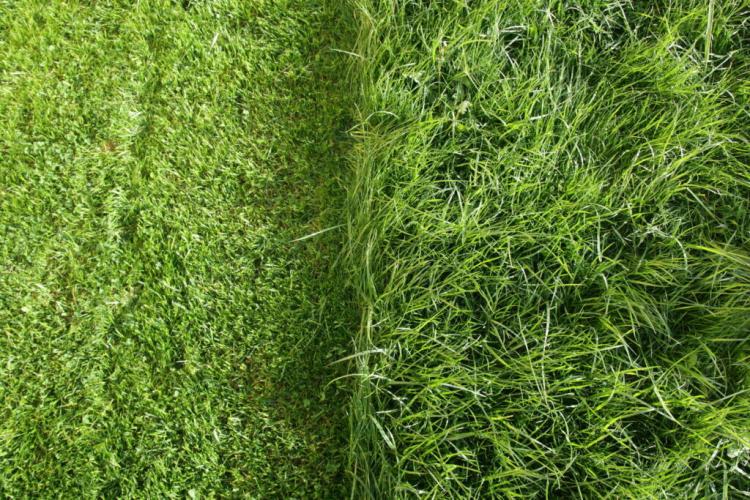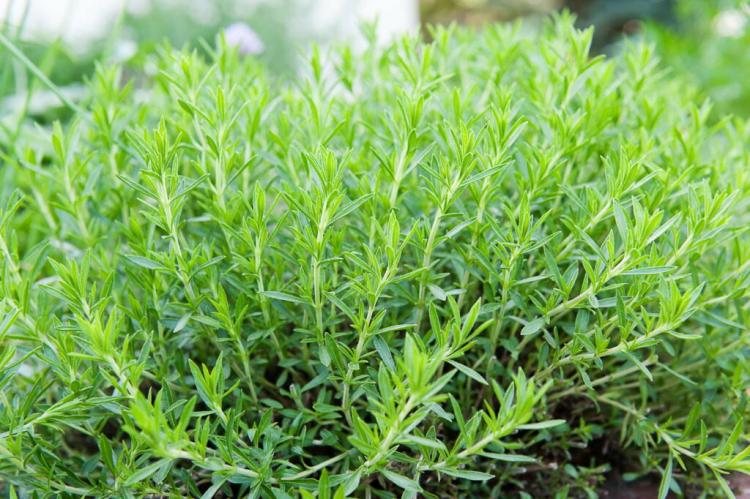Strawberries On The Balcony: Planting In Pot & Pallets
Strawberries can enrich your balcony not only in pots, but also in flower boxes or in a vertical tube. We’ll give you tips and tricks.
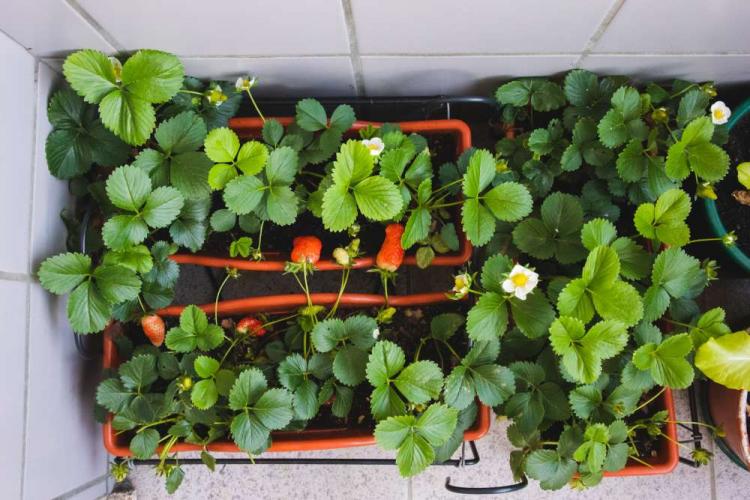
Strawberries are very suitable for growing on the balcony [Photo: lccarvalho / Shutterstock.com]
Gardening on the balcony is trendy. More and more often, balconies are turning into beautiful plant paradises in which they bloom and thrive. Growing fruit and vegetables on the balcony is also no problem with the right species and varieties. Strawberries ( Fragaria ) grow low, are adaptable and therefore particularly suitable for balconies. They also require little space and delight large and small balcony owners with their tasty fruits. We’ll tell you what options there are to plant strawberries on the balcony and how you can best go about it.
Ways to grow strawberries on the balcony
Table of Contents
Strawberries are very shallow roots. A large part of its fine roots are located in the top 15 cm of the soil. This means that 15 cm high containers are theoretically enough to plant strawberries in them. However, taller planters make watering easier – especially on hot summer days – because the water stays longer in them. The strawberry plants should be planted about 25 cm apart. Depending on the size and nature of each balcony, there are different options for planting strawberries.
Ways how strawberries can be grown on the balcony:
- Place individual plants in pots with a diameter of about 12-15 cm and a height of at least 15 cm.
- Plant several strawberry plants in shallow planters, a flat “raised bed” or flower boxes: height at least 15 cm, distance between the plants about 25 cm.
- Growing strawberry plants vertically: In plant tubes or plant walls, on easels or the like.
- On the back of pallets, which can be used as seating, for example.
- Hanging in a hanging basket.
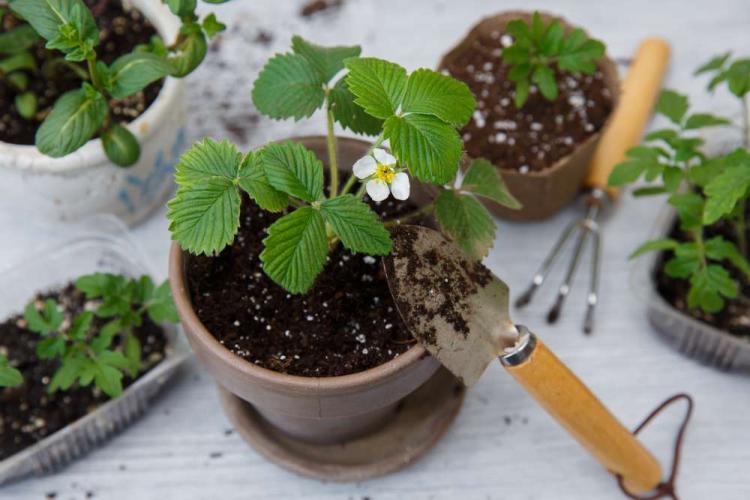
Individual strawberry plants can be planted in 12-15 cm pots [Photo: Lyona / Shutterstock.com]
Strawberries on the balcony: climbing and hanging strawberries
You can think about so-called hanging and climbing strawberries, especially if you have limited space available, but you want to green vertically. All strawberry varieties that produce strong runners are suitable for climbing as well as hanging in traffic lights. If you want to get a climbing strawberry, the tendrils are guided upwards on a scaffold. If you do not do this, you automatically have hanging strawberries because the runners hang down from the mother plant. With these varieties, which form many runners, one must not forget that a lot of energy is required for them. Accordingly, the yield will be somewhat lower. Traffic light strawberries are also a way of harvesting strawberries on balconies or giving them a decorative effect.
Tip : The numerous runners of hanging and climbing strawberries can of course also be used to propagate the strawberry variety. To do this, cut the connection to the mother plant and place the plants in moist potting soil. If placed in a bright but not sunny position, the runners will soon form roots.
Strawberries in a pot: choice of location
The ideal location for strawberries is sunny, sheltered from the wind and warm. That is why south-facing balconies are particularly suitable for growing strawberries. Since their thick rhizome is sensitive to frost, they should be placed closer to the house wall in winter and ideally also on cold-insulating materials such as wood or styrofoam. Especially in the case of balconies on high floors or rather windy locations, the strawberries should be protected in winter and in the case of late frosts in spring. Jute bags, fleece or a layer of mulch made of leaves are suitable for this. While leaves and fleece can be placed over the plants, pots at risk of freezing are wrapped with jute and fleece.
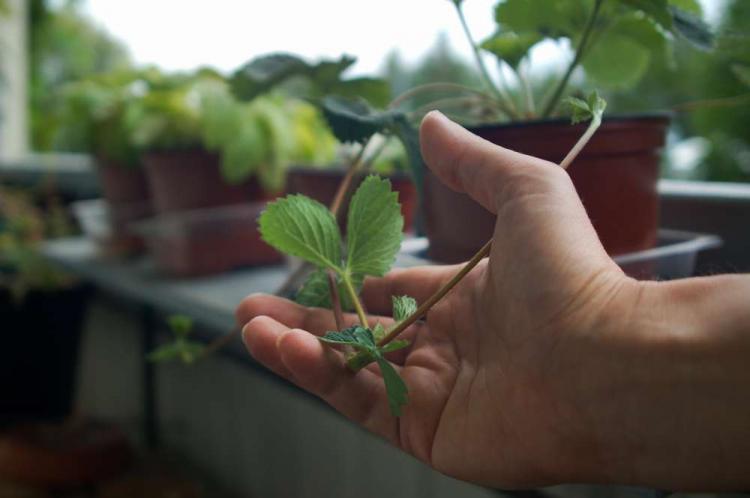
The runners of strawberries can be used to propagate the next generation [Photo: ULD media / Shutterstock.com]
Planting strawberries on the balcony: planting time and instructions
The optimal planting time for strawberries is early July to mid-August. If you plant at this time, you can expect the first harvest as early as next year. Planting is also possible until September or spring, but then it usually takes a year longer before the first fruits can be expected. The so-called frigo strawberries (in “A +” quality) are an exception to this. They can be planted between the beginning of April and the end of June and bear ripe fruit after about eight weeks. But they are a bit more expensive and not available in every garden center. The early fertility of the frigo plants is possible because the runners that became frigo plants were separated much later than normal. So they could already form flower systems as runners.
Strawberries are planted in nutrient-rich potting soil or compost. The distance to the next plant, wall or similar should be about 25 cm (15 cm for monthly strawberries). When planting strawberries, you should pay close attention to the correct planting depth, as the transition between the roots and the shoot is minimal. If the plants are too deep, the heart leaves (the small tips of vegetation in the middle of the plant) or the roots can rot easily. If the plants are too high, however, there is a risk that the plant will dry out.
A drainage layer on the bottom of the planter ensures that the water drains well and effectively prevents waterlogging. Our Plantura organic compost soil is also suitable for growing strawberries on the balcony. The high compost content promotes a loose and permeable soil structure, stores moisture and releases it to the plant roots when required. The special nutrient composition has a particularly beneficial effect on plant growth. The high potassium and magnesium content in our organic soil benefits the strawberry plants.
Immediately after planting, you should water the young strawberry plants vigorously once. During the next two to three weeks, it is important – especially in high summer temperatures – to always ensure that there is sufficient water supply (preferably water every day or every two days).
Tips for the correct care of balcony strawberries
Strawberries are generally easy to care for and grateful plants. If they are properly watered, fertilized and cut in autumn if necessary, they will produce aromatic fruits every year. Incidentally, strawberry plants are usually replaced after about three years of harvest, because then their yield drops significantly – of course, you can only exchange them later, after all, planting on the balcony can be quite a hassle. However, if you decide to plant fresh strawberries (for example self-grown runners), then you should definitely use fresh potting soil. Strawberries should not be planted after themselves as soil fatigue is common. Young plants suffer from soil-borne diseases, such as gray mold ( Botrytis cinerea ), which are transferred from the old plants to the next generation of strawberry plants via the substrate. This also provides the young strawberries with a fresh, nutrient-rich substrate.
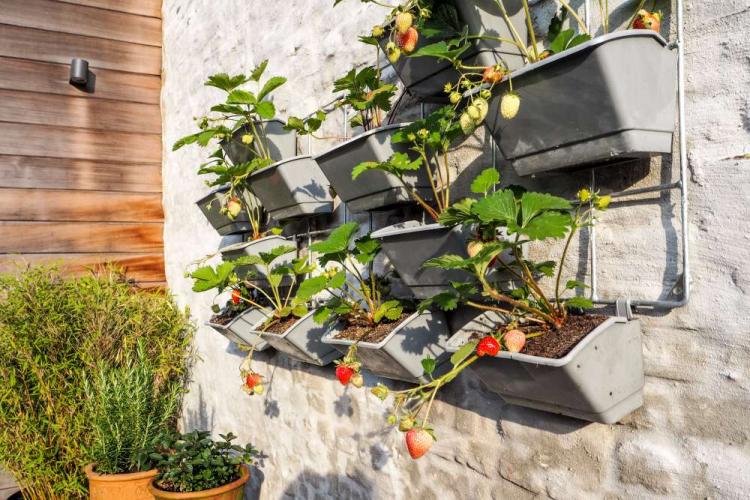
In warm and sunny locations, strawberries should be watered regularly and ideally in the morning [Photo: Luoxi / Shutterstock.com]
Tip: You can still use the old strawberry soil for cress ( Lepidium sativum ), salads ( Lactuca sativa ) or radishes. These plants do not have such high nutritional requirements, are insensitive to strawberry diseases and only stay in the ground for a short time.
Properly water strawberries on the balcony
The sunnier and warmer the location, the higher the strawberries’ need for water, of course. Don’t forget to water your strawberries regularly, especially during flowering and between flowering and fruiting. The smaller the planters, the more regularly they need to be watered. The best time to water is early in the morning, as the plants can absorb enough water by then to withstand the heat that follows. Since strawberries – like most plants – do not tolerate waterlogging, you should not be too generous when watering and ensure that the water drains well. It is better to water less regularly instead of giving large amounts of water less frequently. Also empty plant coasters or planters if the water has been in them for a long time.
Fertilize strawberries properly on the balcony
Strawberries require nitrogen- and potassium-based fertilization. Smaller amounts of phosphorus and magnesium are also required for flower formation and healthy plant growth, but these are usually sufficiently available in the soil. The nutritional requirements of strawberries on the balcony hardly differ from those that grow in the bed. Strawberries usually grow a little stronger in the garden, which means that the need for nutrients is slightly higher, but they have deeper roots.
The easiest way to supply strawberries with nutrients on the balcony is with a liquid fertilizer such as our Plantura organic tomato & vegetable fertilizer. This is simply administered via the irrigation water every one to two weeks between March and October. The purely organic organic liquid fertilizer contains nitrogen and increased potassium levels, which are important for strawberries.
In a nutshell: when, with what and how much is fertilization?
- It is fertilized in the growing season between March and October.
- Use an organic liquid fertilizer with an increased potassium content.
- Dose the amount according to the package description and add every one to two weeks via the irrigation water.
You can find more information about fertilizing strawberries in our special article. You can also find other fruits for cultivation in pots and thus also for cultivation on the balcony.



